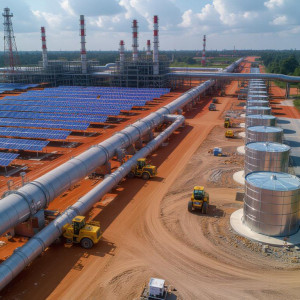China’s Belt and Road Initiative and Freight Growth Signal a New Era for Global Supply Chains

 In the first half of 2025, China's trade and infrastructure investments have converged to create a pivotal moment for global supply chains. A 3% year-over-year growth in freight volume--driven by a 7.2% surge in exports--has underscored China's resilience amid a fragile global economy.
In the first half of 2025, China's trade and infrastructure investments have converged to create a pivotal moment for global supply chains. A 3% year-over-year growth in freight volume--driven by a 7.2% surge in exports--has underscored China's resilience amid a fragile global economy.
Simultaneously, record-breaking Belt and Road Initiative (BRI) investments in energy, mining, and logistics have signaled a strategic pivot toward infrastructure equity and supply chain resilience. For investors, this dual momentum represents a rare alignment of macroeconomic tailwinds and capital allocation opportunities in sectors poised for long-term gains.
Freight Growth: A Barometer of Resilience
China's H1 2025 trade performance defies the broader economic pessimism that has gripped much of the world. Total imports and exports reached £3.02 trillion, with exports hitting a record £13 trillion.
While imports dipped 2.7% YoY, the trend improved by 1.1 percentage points compared to the first five months of the year, indicating a gradual normalization of global demand. June's 5.2% trade growth--second only to 2021's peak--was fueled by strong demand for high-value goods like electric vehicle (EV) components and maritime infrastructure. This growth is not just a function of China's domestic policy but a reflection of its role as a linchpin in global supply chains.
As U.S. and European markets grapple with inflation and protectionism, China's ability to adapt its export basket--shifting toward technology-driven and green energy sectors--has insulated its trade from the worst of the slowdown. The 7.2% export growth, for instance, was driven by a 12% increase in high-tech product shipments, including EV batteries and photovoltaic panels.
BRI Investments: Building the Infrastructure of the Future
While trade data highlights China's economic agility, the BRI's £124 billion in H1 2025 investments reveals a more strategic narrative. This figure, nearly double the 2024 H1 total, reflects a shift from volume-driven construction contracts to high-impact infrastructure equity and resource-backed projects.
Key sectors include:
- Energy and Green Transition:
- Fossil Fuel Projects: Oil and gas investments reached £44 billion, anchored by the £20 billion Ogidibgon Gas Revolution Park in Nigeria. These projects secure energy access for BRI partner nations while creating long-term revenue streams for Chinese firms.
-
Renewables: £9.7 billion flowed into wind, solar, and green hydrogen initiatives, including Longi Green Energy's hydrogen projects in Nigeria. With global green energy demand expected to grow at 8% annually through 2030, these investments are not just strategic but speculative.
-
Metals and Mining:
-
Kazakhstan received £19.5 billion in aluminum and copper projects, ensuring China's access to critical raw materials for EVs and green tech.
Private firms like Xinfa Group and East Hope Group are now leading these efforts, reducing reliance on state-owned enterprises and improving project efficiency.
-
Logistics and Trade Corridors:
- £66.2 billion in construction contracts focused on ports, railways, and data centers. These projects are designed to decongest traditional trade routes and create alternative corridors, such as the China-Europe Railway, which saw a 15% increase in container volume in H1 2025.
The Private Sector's Ascendancy
A notable trend in H1 2025 is the rise of private Chinese enterprises in BRI financing. Companies like Longi Green Energy (solar PV), China Aviation Lithium Battery (EV batteries), and Xinfa Group (mining) now account for over 40% of BRI investments.
This shift reduces geopolitical risks associated with state-led projects and introduces market-driven efficiency. For instance, Longi's green hydrogen venture in Nigeria has already secured a 10-year power purchase agreement, offering predictable cash flows--a rarity in volatile emerging markets.
Strategic Implications for Investors
The convergence of freight growth and BRI investments creates a unique inflection point for capital. Here's how to position for it:
- Infrastructure Equity Plays:
- Energy Sector: Prioritize firms involved in green hydrogen (e.g., Longi Green Energy) and gas infrastructure (e.g., Sinopec).
The £20 billion Nigeria gas park, for example, is expected to generate £1.2 billion in annual revenue by 2030.
-
Mining and Metals: Target companies with exposure to Kazakhstan's aluminum and copper projects. Xinfa Group's £7.5 billion copper investment is a case study in securing raw material dominance.
-
Logistics and Supply Chain Resilience:
-
Invest in firms building trade corridors, such as China Railway Construction Corporation, which executed £15 billion in railway projects in H1 2025. These projects are critical for reducing China's reliance on maritime routes and diversifying trade flows.
-
Private Sector Opportunities:
- Allocate capital to private Chinese firms with BRI exposure.
Their agility and focus on high-margin projects (e.g., EV battery factories in Europe) make them more resilient to global downturns than state-backed peers.
The Road Ahead
As global supply chains fragment and energy transitions accelerate, the BRI's focus on infrastructure equity and resource security will only intensify. For investors, the 3% freight growth in H1 2025 is not just a headline--it's a signal that China's trade corridors are evolving into high-yield assets. By aligning with the BRI's strategic pivot, investors can capitalize on the next decade's defining theme: the reinvention of global trade through infrastructure-driven resilience.
Investment Takeaway:
- Short-Term: Overweight energy and mining equities with BRI exposure.
- Long-Term: Position in logistics and green hydrogen infrastructure, which are foundational to the BRI's 2035 vision.
In an era of economic uncertainty, the BRI's H1 2025 momentum offers a blueprint for investing in the infrastructure that will define the next decade of global trade.